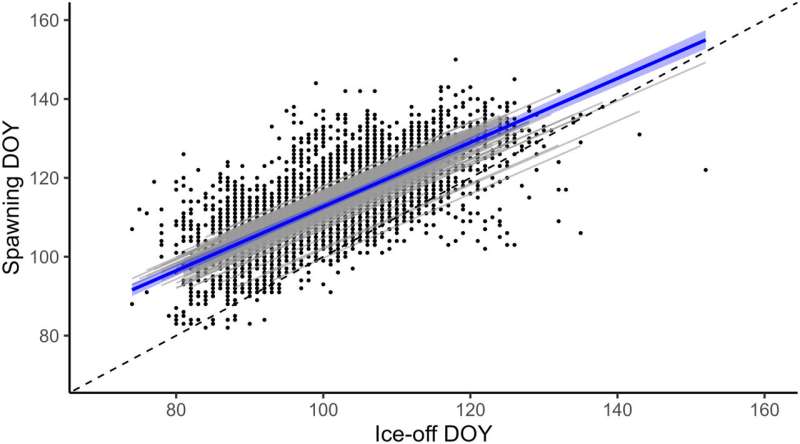
Relationship between walleye (Sander vitreus) spawning dates and ice-off dates across 194 Upper Midwestern lakes. Black points are observed data, thin gray lines are lake-specific trends, and colored lines and shaded areas are the global relationship and 95% credible interval (CI) from a hierarchical linear regression model. Dashed line represents a 1 : 1 relationship to demonstrate that the ice-walleye relationship is less than 1 (slope and CI: 0.81, 0.79–0.83). Credit: Limnology and Oceanography Letters (2024). DOI: 10.1002/lol2.10383
Walleye are one of the most sought-after species in freshwater sportfishing, a delicacy on Midwestern menus and a critically important part of the culture of many Indigenous communities. They are also struggling to survive in the warming waters of the Midwestern United States and Canada.
According to a new study published Feb. 26 in the journal Limnology and Oceanography Letters, part of the problem is that walleye are creatures of habit, and the seasons—especially winter—are changing so fast that this iconic species of freshwater fish can’t keep up.
The timing of walleye spawning—when the fish mate and lay their eggs—has historically been tied to the thawing of frozen lakes each spring, says the study’s lead author, Martha Barta, a research technician at the University of Wisconsin–Madison. Now, due to our changing climate, walleye have been “unable to keep up with increasingly early and more variable ice-off dates,” Barta says.
Within a few days of ice-off, when a lakes’ frozen lid has melted away, walleye begin laying eggs and fertilizing them. In a normal year, that timing sets baby fish up for success once they hatch. But, Barta says, “climate change is interrupting the historical pairing of ice-off and walleye spawning, and that threatens the persistence of walleye populations across the Upper Midwest.”
Barta—who began working on the study as an undergraduate student at UW–Madison’s Center for Limnology—and her colleagues used data from walleye surveys from various state natural resource departments and the Great Lakes Indian Fish & Wildlife Commission, as well as the spring harvest counts from Ojibwe tribal nations to track the fate of walleye populations on 194 lakes across Minnesota, Wisconsin and Michigan.
The data revealed “mismatches” in ice-off and spawning on almost every single lake. While there has been a slight shift to earlier spring spawning dates for walleye, the ice-off dates on those lakes were shifting at a rate of three times faster.
Suddenly, the timing is all wrong for walleye, explains Zach Feiner, a fisheries scientist with both the UW–Madison Center for Limnology and the Wisconsin Department of Natural Resources.
“In an average ice-off year, you have this nice progression of events,” Feiner says. “The ice goes off, you get light and warmer water that creates a bloom of small plant life called phytoplankton. And then tiny animals called zooplankton emerge and eat the phytoplankton, and usually, the walleye spawning is timed for them to hatch when zooplankton are around in high abundance and can serve as fish food for the baby walleye.”
But lately, the timing of yearly thaws has gotten “weird,” says Feiner. Lakes are, on average, thawing earlier, but the number of winters where lakes thaw late is also increasing. The shifts throw off the timing of phytoplankton blooms, zooplankton emergence and walleye hatch, breaking their linked progression as winter transitions to spring.
“When the fish hatch, there aren’t enough zooplankton around, and walleye don’t have enough food to survive,” Feiner says.
On a year-to-year basis, that isn’t necessarily a problem, as adult walleye can always spawn again the next year, when conditions may be more favorable and more of their offspring can survive and increase the population. But, Feiner says, the heightened variability of spring thaws is “increasing the frequency of bust years, and we’re not seeing many or any boom years for a lot of walleye populations.”
While this is obviously bad news for walleye and the people who depend on them, the study underscores the need to identify and protect lakes that can offer refuge in bad years.
“There is a need now to find places where, through management of things we can control—like land use, fish harvest and invasive species—we can buffer or boost their resiliency to be able to handle stuff we can’t control, like climate change,” Feiner says
If fisheries managers can identify lakes where walleye populations are doing relatively well, they can try to keep conditions optimal so that the fish can take advantage during the increasingly rare years when ice-off and their spring spawn do line up.
Then there is also the question of what our “weird” winters mean for other fish species.
“Most of our big-time sportfish species in the Midwest, like walleye, perch, pike, bass, bluegill and muskies, spawn in springtime,” Feiner says. Other species like lake trout and whitefish spawn in the fall, and their eggs overwinter under the ice.
Feiner hopes to expand the research to see if a pattern extends to other fish prized by people—or if some of them are resilient to less-predictable ice-off timing.
More information:
Martha E. Barta et al, Lagging spawning and increasing phenological extremes jeopardize walleye (Sander vitreus) in north‐temperate lakes, Limnology and Oceanography Letters (2024). DOI: 10.1002/lol2.10383
Citation:
Walleye struggle with changes to timing of spring thaw, researchers find (2024, February 27)
retrieved 27 February 2024
from https://phys.org/news/2024-02-walleye-struggle.html
This document is subject to copyright. Apart from any fair dealing for the purpose of private study or research, no
part may be reproduced without the written permission. The content is provided for information purposes only.
>>> Read full article>>>
Copyright for syndicated content belongs to the linked Source : Phys.org – https://phys.org/news/2024-02-walleye-struggle.html
